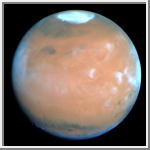|
COMETS EARTH JUPITER KUIPER BELT MARS MERCURY METEORITES NEPTUNE OORT CLOUD PLUTO SATURN SOLAR SYSTEM SPACE SUN URANUS VENUS ORDER PRINTS
PHOTO CATEGORIES SCIENCEVIEWS AMERICAN INDIAN AMPHIBIANS BIRDS BUGS FINE ART FOSSILS THE ISLANDS HISTORICAL PHOTOS MAMMALS OTHER PARKS PLANTS RELIGIOUS REPTILES SCIENCEVIEWS PRINTS
|
Related Document
Download Options
This NASA Hubble Space Telescope view of the planet Mars is one of the clearest pictures ever taken from Earth, surpassed only by close-up shots sent back by visiting space probes. The picture was taken on February 25, 1995, when Mars was at a distance of approximately 65 million miles (103 million km) from Earth. Because it is spring in Mars' northern hemisphere, much of the carbon dioxide frost around the permanent water-ice cap has sublimated, and the cap has receded to its core of solid water-ice several hundred miles across. The abundance of wispy white clouds indicates that the atmosphere is cooler than seen by visiting space probes in the 1970s. Morning clouds appear along the planet's western (left) limb. These form overnight when Martian temperatures plunge and water in the atmosphere freezes out to form ice-crystal clouds. A crescent-shaped cloud just right of center identifies the immense shield volcano Olympus Mons, which is 340 miles (550 km) across at its base. Warm afternoon air pushed up over the summit forms ice-crystal clouds downwind from the volcano. Farther to the east (right) a line of clouds forms over a row of three extinct volcanoes which are from north to south: Ascraeus Mons, Pavonis Mons, Arsia Mons. It's part of an unusual, recurring "W"-shaped cloud formation that once mystified earlier ground-based observers. This picture was taken with Hubble's Wide Field Planetary Camera 2 in PC mode. Exposures were taken through three different color filters to create this true color image. The pictures were map-projected onto a sphere for accurate registration and perspective.
Credit: Philip James (University of Toledo),
Steven Lee (University of Colorado),
NASA
|
